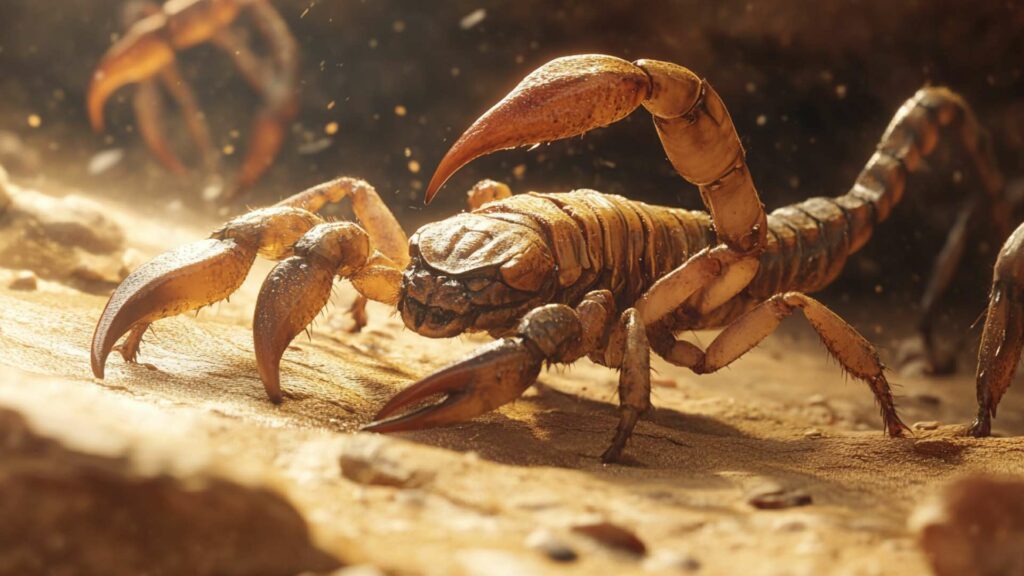Are Scorpions Arachnids?
Scorpions are fascinating creatures that have been around for a very long time. They are one of the first animals to have evolved on Earth, with their lineage dating back over 400 million years. Today, there are thousands of species of scorpions found all over the world, from South America to Africa to Asia.
But what exactly makes a scorpion an arachnid? Well, it turns out that arachnids are a group of joint-legged invertebrates that include spiders, ticks, and scorpions.
These creatures are characterized by two body segments (the cephalothorax and the abdomen), eight legs, and usually no wings or antennae. Scorpions are particularly interesting because they have several unique features that set them apart from other arachnids.
For one thing, they have long grasping pincers (called pedipalps) that they use to catch prey and defend themselves against predators. They also have a sting on the end of their tail which can be used for defense or to subdue their prey.
Despite their somewhat ominous appearance and reputation as dangerous species, most scorpions pose little threat to humans. Only a few species have venom strong enough to cause serious harm or death in humans – much like a bee sting can kill you.
In this article, we’ll take a closer look at what makes scorpions arachnids and explore some of the fascinating aspects of these incredible creatures – from their anatomy and behavior to their role in medical research. So let’s get started!
Delve into the World of Scorpions: Understanding Their Behavior and Anatomy! Curious about scorpions? Discover the hidden wonders of their behavior and anatomy in our comprehensive article. Visit our resource on scorpion behavior and characteristics to learn more!
What are arachnids?
Arachnids are members of the animal kingdom that belong to the class Arachnida. They are characterized by having two main body regions, four pairs of legs, and no antennae or wings. Some of the most well-known arachnids include spiders, ticks, mites, and scorpions.
Definition and examples of arachnids
Spiders are probably the most famous members of the arachnid family. With over 40,000 known species, spiders come in all shapes and sizes. Some are orb-weaving spiders that use silk to construct webs to catch prey while others are burrowing spiders that dig tunnels in soil or sand.
Ticks and mites belong to a group called Acari within the Arachnid class. These tiny creatures have eight legs like all other arachnids but can be distinguished from other members of their class by their small size and flattened bodies.
Scorpions are also members of the Arachnid family. They have a distinct appearance with two large claws at the front end of their body followed by a narrow segment called a pedicel which connects to their larger abdomen at the back end.
Characteristics that define an arachnid
Several characteristics define an arachnid beyond just their physical features like having eight legs. One key characteristic is their breathing system which consists of book lungs or tracheae depending on the species.
Another defining characteristic is their method of reproduction which typically involves males depositing sperm onto specialized structures called pedipalps before transferring them to receptive females during mating. Many arachnids including scorpions produce venom as a means of defense against predators or as a way to immobilize prey before eating it.
The type and potency of venom can vary widely between species. For example, the Arizona bark scorpion is a dangerous species known to produce one of the most potent venoms among scorpions.
Scorpions as Arachnids
Physical characteristics of scorpions that make them arachnids
Scorpions are easily recognizable by their long, segmented tail which ends in a venomous stinger. They also have two large pincers, known as pedipalps, which they use to grab and hold onto prey. Scorpions have eight legs and, like all arachnids, they have two main body sections: the cephalothorax and the abdomen.
But what really sets scorpions apart as arachnids are their unique respiratory organs called book lungs. These are made up of overlapping plates that look like the pages of a book.
Scorpions use these lungs to breathe in oxygen from the air around them. Other arachnids like spiders and ticks breathe through structures called tracheae instead.
Comparison to other arachnids such as spiders and ticks
While scorpions share many physical characteristics with other arachnids like spiders and ticks, there are some key differences between these groups of animals. For example, unlike scorpions which have six equal-sized legs, spiders have two large front legs used for grasping prey while their remaining four legs are smaller and used for movement.
Ticks on the other hand have eight legs but their bodies lack distinct segments like those found in scorpions or spiders. Another interesting difference is that while many species of spiders produce silk from specialized glands located at the base of their genital opening, most species of scorpions do not produce silk at all.
Both male and female scorpions possess venom glands in their tails which they use to subdue prey or defend themselves against predators or threats; this makes them particularly dangerous as pets. Overall, while there may be similarities between different types of arachnids, each group has unique and fascinating qualities that set them apart from the rest.
Anatomy of a Scorpion
The Physical Composition of a Scorpion
Scorpions are arachnids known for their unique appearance and, in some species, venomous sting. A scorpion’s body is divided into three main parts: the head, thorax, and abdomen. The head contains the scorpion’s eyes, pincers (also known as pedipalps), and mouthparts.
The thorax includes four pairs of legs used for walking and grabbing prey. The abdomen is a segmented tail that ends in a venomous stinger.
The Importance of Each Body Part
The pincers found on the scorpion’s head are used to grasp prey or defend against predators. In some species such as Scorpio maurus, they can also be used to emit fluorescent material found in their exoskeletons which helps to identify them from other species of scorpions.
The eight legs found on the thorax aid in movement and also play an important role in providing stability when hunting or protecting themselves. The first pair of legs act as feelers while the last pair is modified into sensory organs that are used to detect vibrations from their environment.
The segmented tail at the end of a scorpion’s body outwardly appears menacing but serves more purposes than just delivering its venomous sting. It acts as another sensory organ that picks up minute vibrations or movements around them which help with hunting or avoiding danger
Let us not forget about what makes scorpions so notorious – their stingers! Found at the end of its tail, these appendages are made up of two parts: basal segment containing muscles and poison glands that produce venom; And aculeus or needle-like tip that pierces through flesh when deployed by an angry or threatened Scorpion.
A thorough understanding of scorpion anatomy is essential to understanding their habits and behavior. With this knowledge, one can appreciate the vital functions of each body part and how they all work together to help scorpions survive. Whether it’s hunting for prey or defending themselves against predators, these arachnids’ unique physical characteristics have proven to be advantageous throughout evolution.
Types of Scorpions
The Emperor Scorpion: King of the Scorpions

The Emperor scorpion is one of the most popular species and is native to Africa. It’s the largest scorpion species in the world, with its average length being approximately eight inches.
The emperor scorpions are black, but under ultraviolet light, they show a blue-green fluorescent material found on their ventral side which helps them attract prey. These scorpions live in tropical rainforests and can be found in small groups where they share burrows.
Bark and Dead Scorpions: The American Species

In North America, there are a few species of scorpions that can be found. One common species is the bark scorpion, which is known for its venomous sting and yellow-brown coloration.
These types of scorpions live in arid areas such as deserts and can be found hiding under rocks or woodpiles. Another common scorpion species is the dead scorpion.
It gets its name from its habit of playing dead when threatened by predators or humans. They come in various colors, ranging from yellow to brown to greenish-grey, depending on their habitat.
South American Scorpion Species

The Brazilian Yellow Scorpion is another large specie that measures up to 4 inches long from South America. Its venom contains toxins useful for medical research due to their high anti-tumor activity that could lead to new cancer treatment development. There are also some unique South American species such as the giant hairy desert dweller Hadrurus arizonensis which measures up to 5 inches long; it has eight legs instead of most modern scorpions with only six legs.
Scorpions glow in UV lights because their exoskeletons contain fluorescent molecules which also offer excellent camouflage from predators such as birds or insects. Some species dig burrows deep into the ground, and others live beneath rocks or trees.
Overall, there are over 2,000 species of scorpions in the world, each with its unique characteristics and habitat. Understanding these differences is essential not only for appreciating these fascinating animals but also for staying safe around them.
Behavior and Diet
Hunting and Eating Habits of Scorpions
Scorpions are fascinating creatures. They are one of the oldest species in the animal kingdom, having evolved more than 400 million years ago during the Silurian period. Scorpions belong to a group of amazing arachnids that includes spiders, mites, and ticks.
These creatures have been around since the first animals with two body segments appeared on earth. Scorpions are primarily nocturnal hunters, which means they hunt at night.
They use their powerful legs to move around and find their prey. Once they locate a potential meal, they use their segmented tail to inject venom into it.
The venom quickly paralyzes or kills the animal, making it easier for the scorpion to eat. When it comes to eating habits, scorpions are opportunistic feeders.
This means that they will eat almost anything they can catch including insects, spiders, mites, and other small animals. In some cases, scorpion species dig burrows where they can wait for a prey item to pass by before striking.
Defense Mechanisms of Scorpions
Like most arachnids, scorpions have developed various methods for protecting themselves from predators. One of these methods is their sting which can be deadly in some cases. Scorpions also have thick exoskeletons that provide an extra layer of protection against predation.
Some species also have hairs on their bodies called setae which help them sense vibrations in the environment. Interestingly enough, female scorpions tend to be more aggressive than males when it comes to defending themselves and their young from predators or other threats.
Interesting Facts about Scorpion Behavior Patterns
Did you know that some scorpion species glow under ultraviolet light? This phenomenon is known as fluorescence and is thought to be a form of communication between other scorpions.
Another interesting fact about scorpions is that they can survive for months without food. This is because they have a slow metabolism and can store fat in their bodies.
Additionally, some species of scorpions live in groups called colonies. These colonies are made up of several individuals who work together to hunt, protect their territory, and care for their young.
Scorpions are amazing creatures that have unique behavior patterns when it comes to hunting, eating and protecting themselves from predators. Understanding the behavior patterns of different types of scorpion species can provide insights into medical research on new treatments for venomous scorpion stings.
Venomous Scorpions: The Danger Lurking in the Desert
Scorpions are commonly known for their venomous stings, but not all scorpions are dangerous to humans. Less than 30 of the 1,500 known species of scorpions have venom strong enough to cause serious harm to a healthy adult human. However, it is important to be able to identify and differentiate between venomous and nonvenomous stinger of scorpions in order to avoid potentially dangerous encounters.
Venomous scorpions have specialized stingers located at the end of their long tails that they use as a defense mechanism against predators and to kill prey too. These stingers contain a potent cocktail of toxins that can cause pain, swelling, and even death in extreme cases.
Nonvenomous scorpions may also have stingers but cannot produce harmful toxins. The effects of a sting from a venomous scorpion vary depending on the species and severity of the sting.
Symptoms can range from mild discomfort and local swelling to more severe reactions such as muscle spasms, respiratory distress, and even death. Children, elderly individuals, and those with weakened immune systems are particularly vulnerable to severe reactions.
Surviving a Scorpion Sting: First Aid Tips
If you or someone you know has been stung by a scorpion (venomous or nonvenomous), it is important to administer first aid immediately. The following steps can help alleviate symptoms:
1) Wash the affected area with soap and water 2) Apply a cool compress or ice pack wrapped in cloth
3) Elevate the affected limb if possible 4) Take over-the-counter pain medication if necessary
It is important to seek medical attention if symptoms worsen or do not improve within an hour or two after initial treatment. If possible, try to capture the offending scorpion (dead or alive) and bring it with you to the hospital for proper identification.
The Good, the Bad, and the Fluorescent: The Fascinating World of Scorpion Venom
Despite their reputation as dangerous predators, scorpions have long been studied for their unique and fascinating venom. In recent years, scientists have discovered that some species of scorpions produce fluorescent material in their venom that can be used for medical imaging purposes.
But not all scorpion venom is benign. Some species produce toxins that can be used as painkillers or even potential cancer treatments.
One species of burrowing spider-hunting scorpion has venom that contains a compound capable of blocking pain signals to the brain. While there is still much to learn about scorpion venom and its potential applications, it is clear that these arachnids are more than just desert pests – they are an important part of our natural world with much to offer in terms of scientific discovery and medical research.
Understanding the Importance of Scorpions as Arachnids
Scorpions are fascinating creatures that have been around for millions of years. They are an incredibly diverse group of arachnids, with more than 2,000 different species found all over the world.
Understanding what makes a scorpion an arachnid is important not just for scientific classification, but also for appreciating the unique characteristics and abilities of these animals. One reason why it’s important to understand that scorpions are arachnids is because it helps us to understand their place in the animal kingdom.
Like spiders and ticks, scorpions belong to one of the largest groups of animals on Earth, and they share many important traits with other members of this group. By understanding these shared traits and characteristics, we can gain a better understanding of how these animals have evolved.
Another reason why it’s important to understand that scorpions are arachnids is because it can help us to appreciate their unique abilities and adaptations. For example, most scorpions have venom glands that they use primarily for hunting prey or defending themselves from predators.
In some species, such as the Emperor Scorpion (Pandinus imperator), this venom is powerful enough to cause serious harm or even death in humans. Understanding that scorpions are arachnids can also help us to appreciate their incredible ability to fluoresce under ultraviolet light.
This glow is caused by special chemicals in the scorpion’s glow their exoskeletons which absorb UV light and emit it as visible light. This adaptation allows desert scorpions like Scorpio Maurus to be active at night when temperatures are cooler.
Despite their fearsome reputation and potentially deadly sting, most species of scorpion are harmless to humans and play important roles in ecosystems around the world. Many species feed on insects or other small animals like mites and ticks, and their presence in an area can help to control populations of these pests.
Young scorpions are also an important food source for many other animals too, including birds and other predators. Understanding what makes a scorpion an arachnid is important for appreciating the unique characteristics and abilities of these fascinating creatures.
By understanding their place in the animal kingdom, we can gain a better appreciation for how they evolved, and by understanding their unique adaptations and behaviors, we can appreciate the important roles they play in ecosystems around the world. So next time you encounter a scorpion, take a moment to appreciate this amazing animal – after all, it’s not every day that you get to see an arachnid with eight legs!
D-Termination: Las Vegas’ top-tier pest control service, is your ultimate solution for combating Scorpions

Worried about the presence of scorpions on your Las Vegas property? Rest assured, as D-Termination has got you covered. Our team of skilled professionals specializes in eradicating these venomous pests, guaranteeing a safe environment for you. Wave goodbye to scorpion concerns by opting for D-Termination’s highly effective pest control services today!
To secure your scorpion control service and reclaim your space from these unsettling creatures, reach out to us at 702-919-6310 or visit dtermination.com.
Frequently Asked Questions:
Yes, scorpions are considered arachnids.
The three types of arachnids are spiders, scorpions, and ticks.
Scorpions are classified as arachnids because they possess the characteristic traits of arachnids, such as having eight legs and belonging to the class Arachnida.
No, spiders and scorpions are not the only arachnids. Other examples of arachnids include ticks, mites, and harvestmen.








